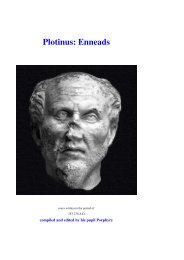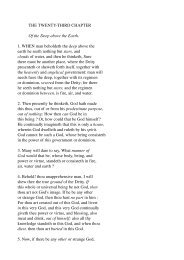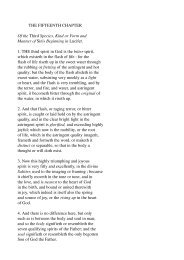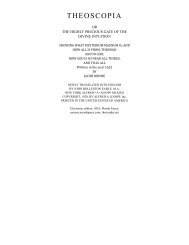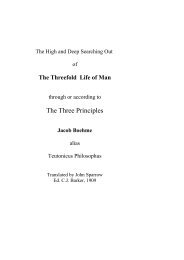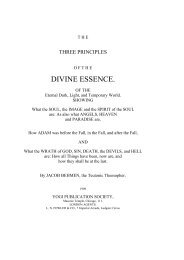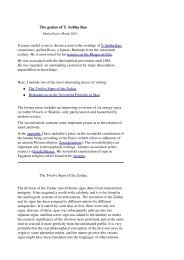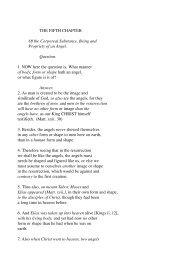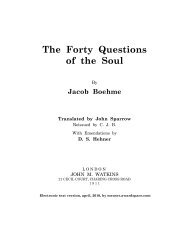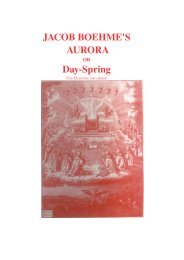Gerald Massey's Lectures - Society in evolution - Awardspace
Gerald Massey's Lectures - Society in evolution - Awardspace
Gerald Massey's Lectures - Society in evolution - Awardspace
You also want an ePaper? Increase the reach of your titles
YUMPU automatically turns print PDFs into web optimized ePapers that Google loves.
of the supposed history. Philo tells us--"They regard the letter of each utterance as the<br />
symbol of that which was concealed from sight, but was revealed <strong>in</strong> the hidden<br />
mean<strong>in</strong>g"--not by its be<strong>in</strong>g rationalised <strong>in</strong>to history. Mythology is, <strong>in</strong> its way, as real as<br />
mathematics, but its way is not that of the literalisers, who have made the symbolism<br />
false on the face of it to the underly<strong>in</strong>g natural facts.<br />
The fall of man, the temptation of the serpent and the com<strong>in</strong>g of a Messiah were not<br />
historic realities, which the Gnostics converted <strong>in</strong>to their allegories. It is altogether<br />
mislead<strong>in</strong>g to speak of the allegoriz<strong>in</strong>g Essenic and Docetic methods of exegesis, as if the<br />
Gnosis consisted <strong>in</strong> whittl<strong>in</strong>g away and attenuat<strong>in</strong>g the solid facts of history! That is<br />
merely echo<strong>in</strong>g the language of those who were at war with the Gnostic <strong>in</strong>terpretation, on<br />
behalf of the supposed history by which we have been misled. The allegories were first;<br />
and they are f<strong>in</strong>al; the history had no deeper foundations. The Essenes knew the hidden<br />
nature of these representations and taught it "through symbols, with time-honoured zeal,"<br />
be<strong>in</strong>g <strong>in</strong> possession of the books of wisdom and other scriptures than ours. They were the<br />
jealous preservers of the hidden Gnosis, and qualified expounders of the ancient<br />
mysteries by means of the secret tradition. The <strong>in</strong>itiate was sworn to keep secret the<br />
scriptures of the hidden wisdom and not to communicate the Gnosis to others, not even to<br />
a new member except <strong>in</strong> the same way <strong>in</strong> which it had been communicated to him. But it<br />
was especially prescribed that the "Doctr<strong>in</strong>e of the Angels," i.e. of the time cycles, was<br />
not to be revealed to any non-Essene. Unfortunately that secresy <strong>in</strong> the mode of<br />
communication became the fatal curse of all the ancient knowledge by allow<strong>in</strong>g the false<br />
to come first <strong>in</strong> be<strong>in</strong>g publicly proclaimed.<br />
De Qu<strong>in</strong>cy, <strong>in</strong> his essay on the Essenes, has remarked on the monstrosity of the omission<br />
when the Christians are not even mentioned by the Jewish historian, Josephus. There is<br />
the same portentous omission when the Essenes are never mentioned <strong>in</strong> the Christian<br />
Gospels. They are there <strong>in</strong> fact, though not by name; nor as any new-born brotherhood.<br />
They are only there <strong>in</strong> disguise, because historic Christianity has drawn the mask over the<br />
features of primitive Christianity. The existence of primitive and pre-historic Christians is<br />
acknowledged <strong>in</strong> the Gospel accord<strong>in</strong>g to Mark when John says,--"Master, we saw one<br />
cast<strong>in</strong>g out devils <strong>in</strong> thy name, and he followeth not us." That, as the context shows, was<br />
done <strong>in</strong> the name of the Christ, and, consequently, such were Christians. Accord<strong>in</strong>g to the<br />
account <strong>in</strong> Matthew, before ever a disciple had gone forth or could have begun to preach<br />
historic Christianity, there was a widespread secret organization ready to receive and<br />
bound to succour those who were sent out <strong>in</strong> every city of Israel. Who, then, are these?<br />
They are called "The Worthy." That is, as with the Essenes, those who have stood the<br />
tests, proved faithful, and been found worthy. Accord<strong>in</strong>g to the canonical account these<br />
were the pre-historic Christians, whether called Essenes or Nazarenes; the worthy, the<br />
faithful, or the Brethren of the Lord. "Peace be with you!" was the greet<strong>in</strong>g or pass-word<br />
of the Essenes, and also of the Nazarenes, to judge from its appear<strong>in</strong>g <strong>in</strong> the book of<br />
Adam. And <strong>in</strong> the <strong>in</strong>structions given to the Seventy (Luke x. 5) it is said:--"Into<br />
whatsoever house ye enter first say, 'Peace be to this house.'"<br />
After the resurrection the mystic pass-word is employed three times over by the risen<br />
Christ. And "He who comes with peace" is the name of the Egyptian God, Iu-em-hept,<br />
the son of Atum, who, as the com<strong>in</strong>g son, is Iu-su = Jesus. We also learn from the<br />
Clement<strong>in</strong>e Homilies (3, 19) that the "Mystery of the Scriptures" which was taught by (or<br />
ascribed to) Christ was identical with that which from the first had been communicated to<br />
those who were the Worthy. We may learn from the Gospel accord<strong>in</strong>g to Luke that the<br />
"Worthy" were those who had been <strong>in</strong>itiated <strong>in</strong>to the Mysteries of the Gnosis, and who<br />
were "accounted Worthy" to atta<strong>in</strong> that "resurrection from the dead" <strong>in</strong> this life, which<br />
Paul was not altogether sure about--"those who knew that they could die no more, be<strong>in</strong>g<br />
equal to the angels as sons of God and sons of the Resurrection." Such were then extant<br />
as pre-Historic Christians (ch. xx. 35-6).



